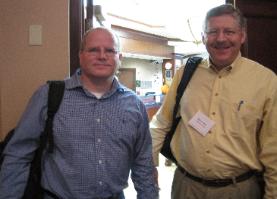FGFs that regulate growth plate development.
Abstract 2005 MHE Conference
David M. Ornitz, Irene Hung, Zhonghao Liu, Kory Lavine,
Kai Yu, Hidemi Kanazawa, Ann Jacob.
Department of Molecular Biology and Pharmacology,
Washington University School of Medicine.
Fibroblast growth factors (FGFs) are essential molecules for mammalian development. A growing number of human genetic
diseases that affect skeletal development are caused by point mutations in the genes encoding FGF receptors 1, 2 and 3. These
disorders result in craniosynostosis and chondrodysplasia syndromes and thus demonstrate that FGF signaling pathways are
essential regulators of chondrogenesis and osteogenesis. Loss of function and skeletal-specific conditional loss of function
mutations in mouse FGF receptors 1-3 also show specific defects in skeletal development and in the structure and integrity of
adult bone.
In contrast to the increasing amount of data demonstrating a role for FGFRs in skeletogenesis, there is very little information on
the FGF ligands that signal to these receptors to regulate skeletal development, growth, remodeling and repair. Mice lacking
FGF2 (bFGF) have a mild decrease in bone mass and trabecular bone formation, but no morphological defects in their skeleton.
Examination of skeletal development in mice lacking FGF18 revealed moderate skeletal dysmorphology and a significant delay in
ossification of distal bones that is not seen in mice lacking FGF receptors 1, 2 or 3 in osteoblast or chondrocyte lineages. In
contrast, analysis of mice lacking Fgf9 revealed a delay in ossification primarily affecting proximal bones. The dysmorphology and
delayed ossification phenotype of these knockout mice suggest that FGF9 and FGF18 signal to skeletal cells (chondrocytes and
osteoblasts) to regulate early skeletal development and to non-skeletal mesenchymal cells to regulate peri-skeletal
vasculogenesis and vascular invasion of the primitive growth plate.
We have also observed that mice lacking both FGF9 and FGF18 have very severe skeletal dysmorphology with delayed
ossification and agenesis of the intramembranous bones of the cranium. These data further suggest that FGF9 and FGF18 form
overlapping and inverted gradients in the appendicular skeleton that regulate both development and vascularization.
Abstract 2005 MHE Conference
David M. Ornitz, Irene Hung, Zhonghao Liu, Kory Lavine,
Kai Yu, Hidemi Kanazawa, Ann Jacob.
Department of Molecular Biology and Pharmacology,
Washington University School of Medicine.
Fibroblast growth factors (FGFs) are essential molecules for mammalian development. A growing number of human genetic
diseases that affect skeletal development are caused by point mutations in the genes encoding FGF receptors 1, 2 and 3. These
disorders result in craniosynostosis and chondrodysplasia syndromes and thus demonstrate that FGF signaling pathways are
essential regulators of chondrogenesis and osteogenesis. Loss of function and skeletal-specific conditional loss of function
mutations in mouse FGF receptors 1-3 also show specific defects in skeletal development and in the structure and integrity of
adult bone.
In contrast to the increasing amount of data demonstrating a role for FGFRs in skeletogenesis, there is very little information on
the FGF ligands that signal to these receptors to regulate skeletal development, growth, remodeling and repair. Mice lacking
FGF2 (bFGF) have a mild decrease in bone mass and trabecular bone formation, but no morphological defects in their skeleton.
Examination of skeletal development in mice lacking FGF18 revealed moderate skeletal dysmorphology and a significant delay in
ossification of distal bones that is not seen in mice lacking FGF receptors 1, 2 or 3 in osteoblast or chondrocyte lineages. In
contrast, analysis of mice lacking Fgf9 revealed a delay in ossification primarily affecting proximal bones. The dysmorphology and
delayed ossification phenotype of these knockout mice suggest that FGF9 and FGF18 signal to skeletal cells (chondrocytes and
osteoblasts) to regulate early skeletal development and to non-skeletal mesenchymal cells to regulate peri-skeletal
vasculogenesis and vascular invasion of the primitive growth plate.
We have also observed that mice lacking both FGF9 and FGF18 have very severe skeletal dysmorphology with delayed
ossification and agenesis of the intramembranous bones of the cranium. These data further suggest that FGF9 and FGF18 form
overlapping and inverted gradients in the appendicular skeleton that regulate both development and vascularization.
Research authored by Dr. Ornitz
Click the tab and a window will appear.
List of Publications via PubMed
(NIH National Library of Medicine)
List of Publications via PubMed
(NIH National Library of Medicine)
| David Ornitz, M.D., Ph.D., research |
| |||||||||||||||||||||||||||||||||||||||||||||||||||||||||||||||||||||||||||||||||||||||||||||||||||||||||||
| ||||||||||
2009 Conference abstract
FGF Signaling in Skeletal Development and Repair
Kai Yu, Gregory Schmid, Mario Martinez, Jennifer McKenzie, Chikashi Kobayashi,
Linda Sandell, Matthew Silva, David Ornitz
Departments of Developmental Biology, Orthopedic Surgery and Biomedical Engineering, Washington University School of
Medicine, St. Louis, MO, USA.
e-mail: dornitz@wustl.edu
Mutations in Fibroblast Growth Factor Receptors result in chondrodysplasia and craniosynostosis syndromes that affect both
long bone and cranial bone development. These skeletal phenotypes underscore the essential role for FGF signaling in skeletal
development. To investigate specific functions of FGFs, mouse models have been used to conditionally inactivate FGF receptors
in different limb bud and skeletal compartments. These studies have identified unique roles for FGF signaling at almost every
stage of skeletal development, beginning at the earliest stages of limb bud formation and continuing throughout embryonic
skeletal development. More recent studies have revealed expression of FGF signaling molecules during postnatal bone growth
and during the repair of skeletal fractures, suggesting additional roles for FGF signaling during adult skeletal growth,
homeostasis and repair.
To address function of FGF receptors, conditional gene disruption is being used to target Fgfr1 and Fgfr2. Prx1-Cre and
Dermo1-Cre effectively target limb bud mesenchyme. Lineage tracing experiments show that these Cre genes target an
osteo-chondro progenitor cell that will give rise to all chondrocytes and osteoblasts in long bones. Although use of these Cre
genes to target FGF receptors suggest roles for FGF signaling during bone development, earlier phenotypes resulting from
defects in the limb bud complicate this analysis. To identify specific roles for FGF receptors in at later stages of development, the
Osx-Cre gene is being used to target Fgfr1 and Fgfr2, in all osteoblasts and a subset of chondrocytes. Osx-Cre conditional
knockout mice display, at birth, severe loss of intramembranous bone but surprisingly normal long bones. However, postnatally,
long bone growth is significantly slowed. These studies show that FGF signaling is essential for normal osteoblast mediated
postnatal bone growth.
To address functions of FGF signaling during fracture repair, we have developed two mouse models. Endochondral repair is
induced with a stabilized tibial fracture model and woven bone repair is induced through an ulnar stress fracture model.
Preliminary studies suggest that induction of FGF signaling during endochondral bone repair decreases chondrogenesis and
leads to increased osteoid formation. Ongoing studies will evaluate the effects induced FGF signaling on bone strength following
complete fracture healing.
FGF Signaling in Skeletal Development and Repair
Kai Yu, Gregory Schmid, Mario Martinez, Jennifer McKenzie, Chikashi Kobayashi,
Linda Sandell, Matthew Silva, David Ornitz
Departments of Developmental Biology, Orthopedic Surgery and Biomedical Engineering, Washington University School of
Medicine, St. Louis, MO, USA.
e-mail: dornitz@wustl.edu
Mutations in Fibroblast Growth Factor Receptors result in chondrodysplasia and craniosynostosis syndromes that affect both
long bone and cranial bone development. These skeletal phenotypes underscore the essential role for FGF signaling in skeletal
development. To investigate specific functions of FGFs, mouse models have been used to conditionally inactivate FGF receptors
in different limb bud and skeletal compartments. These studies have identified unique roles for FGF signaling at almost every
stage of skeletal development, beginning at the earliest stages of limb bud formation and continuing throughout embryonic
skeletal development. More recent studies have revealed expression of FGF signaling molecules during postnatal bone growth
and during the repair of skeletal fractures, suggesting additional roles for FGF signaling during adult skeletal growth,
homeostasis and repair.
To address function of FGF receptors, conditional gene disruption is being used to target Fgfr1 and Fgfr2. Prx1-Cre and
Dermo1-Cre effectively target limb bud mesenchyme. Lineage tracing experiments show that these Cre genes target an
osteo-chondro progenitor cell that will give rise to all chondrocytes and osteoblasts in long bones. Although use of these Cre
genes to target FGF receptors suggest roles for FGF signaling during bone development, earlier phenotypes resulting from
defects in the limb bud complicate this analysis. To identify specific roles for FGF receptors in at later stages of development, the
Osx-Cre gene is being used to target Fgfr1 and Fgfr2, in all osteoblasts and a subset of chondrocytes. Osx-Cre conditional
knockout mice display, at birth, severe loss of intramembranous bone but surprisingly normal long bones. However, postnatally,
long bone growth is significantly slowed. These studies show that FGF signaling is essential for normal osteoblast mediated
postnatal bone growth.
To address functions of FGF signaling during fracture repair, we have developed two mouse models. Endochondral repair is
induced with a stabilized tibial fracture model and woven bone repair is induced through an ulnar stress fracture model.
Preliminary studies suggest that induction of FGF signaling during endochondral bone repair decreases chondrogenesis and
leads to increased osteoid formation. Ongoing studies will evaluate the effects induced FGF signaling on bone strength following
complete fracture healing.



| Photo's taken during the, Third International MHE Research Conference |
The MHE Research Foundation, we comply with the HONcode standard for health trust worthy information: By the Health On the Net Foundation.
Click here to verify.# HON Conduct 282463 and is the patient support link on the US Government Genetics Home Reference (http://ghr.nlm.nih.gov)
website, also linked for Patient Information on The Diseases Database a cross-referenced index of human disease, as well as the
Intute: health & life sciences a free online service providing access to the very best Web resources for education and research located in the UK
Click here to verify.# HON Conduct 282463 and is the patient support link on the US Government Genetics Home Reference (http://ghr.nlm.nih.gov)
website, also linked for Patient Information on The Diseases Database a cross-referenced index of human disease, as well as the
Intute: health & life sciences a free online service providing access to the very best Web resources for education and research located in the UK
The MHE Research Foundation is proud to be working with the EuroBoNeT consortium, a European Commission granted Network of Excellence for
studying the pathology and genetics of bone tumors.
studying the pathology and genetics of bone tumors.
| This website is regularly reviewed by members of the Scientific and Medical Advisory Board of the MHE Research Foundation. All online submission forms use (SSL AES 256 bit encryption (High); RSA 1024 bit exchange) Protocol with Privacy protection. Our goal is to make this website as safe and user friendly as possible. |


| The MHE Research Foundation is a participating member organization of the United States Bone and Joint Decade, (USBJD) & the USBJD Rare Bone Disease Patient Network |
| Written consent must be obtained to attach web pages or the files attached to this website, please email the webmaster. Email the webmaster: webmaster@mheresearchfoundation.org Materials on this website are protected by copyright Copyright © 2009 The MHE Research Foundation Disclaimer: While many find the information useful, it is in no way a substitute for professional medical care. The information provided here is for educational and informational purposes only. This website does not engage in the practice of medicine. In all cases we recommend that you consult your own physician regarding any course of treatment or medicine. This web page was updated last on 12/16/09, 4:0O pm Eastern time |
The MHE Research Foundation is proud to be an affiliate of the Society For Glycobiology





